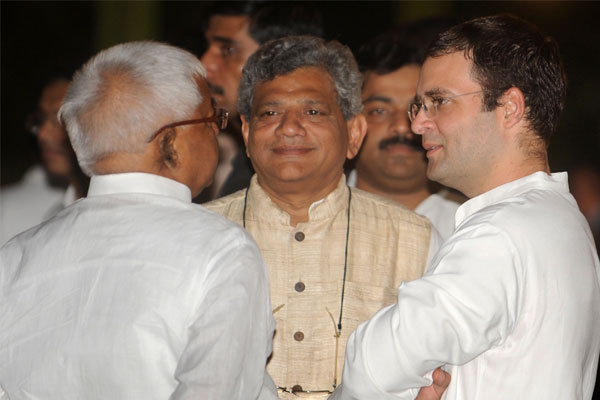
Historically, relations between the Congress party and the Communist parties in India can be described as polemical. India’s first prime minister Jawaharlal Nehru, nominally inclined towards the Communists, without being a doctrinaire, believed that for the Leftists in India, history began with the Bolshevik Revolution.
That rather back handed remark masks the larger ideological cohesion that the two parties have enjoyed, at least on the question of the emergence of the Right in India is concerned.
For the Left, the Congress was traditionally the lesser of the two evils, when compared to the Hindu Right wing, which in Nehru’s time was on the back foot, given India’s first prime minister’s distaste for everything non-scientific, his soaring individual popularity and the fact that the Hindu Mahasabha were seen as Gandhi’s killers. Nonetheless, in 1959, Nehru presided over the cold-blooded dismissal of the first Communist government led by EMS Namboodripad in Kerala.
However, with the rise of the BJP in the 1990s, this terrible dilemma for the Left was compounded. CPM, the larger of the two Communist parties was seen to be divided, if not actually split, between supporting secular parties, read Congress and its allies.
The highlight – and casualty – of this confusion was four-time CPM MP from the Katwa parliamentary constituency of West Bengal, Saifuddin Choudhary, who was inexplicably dropped from the party’s powerful Central Committee in 1995 and denied a ticket for the 1996 Lok Sabha elections, for suggesting that the CPM reach an understanding with the ruling Congress to keep the BJP and ‘fascist’ forces at bay. Such was the outrage within some influential sections of the Left at the mere proposal that Choudhary’s name was struck off the membership rolls of the party.
But this was still the 1990s, a period when the BJP had not come to dominate national politics as it does today. It was a time when the Congress was the predominant political formation in the country.
Today, understandably, the scenario is graver for the CPM, facing as it does the prospect of extinction with 9 Lok Sabha seats that the party won at the height of the so-called Narendra Modi wave in 2014.
Importantly, the question of cooperation with the Congress that dominated the party in the 1990s has refused to go way. From 2004 to 2009, the Left supported the Congress-led government from outside, which broke down on several issues, most notably the Indo-US civil nuclear deal.
Today again, there is a vertical split within the Central Committee of CPM on the question of supporting the Congress in the 2019 Lok Sabha elections, with both sides evenly matched as far as numbers are concerned. The opinions favoured by veteran leader Prakash Karat and general secretary Sitaram Yechury witnessed 32 favouring Karat and 31 backing Yechury.
Not surprisingly, both Karat and Yechury agree that the primary objective of the CPM is to oust the Modi government. Both also believe there cannot be any electoral understanding with the Congress.
However, Yechury believes that the party should seek the cooperation of all non-Left secular parties, including the Congress. This, in effect, will keep a window open as far as the party’s approach towards the Congress is concerned. Karat, on the other hand, believes that the party should cooperate with all “non-Congress” secular parties.
The opinion in the Central Committee, which discussed the ‘minority draft’ submitted by Yechury, a document circulated by the Karat faction as a counter to it, and the ‘outline’ of the draft officially approved by the Politburo, was divided. Averting a vote, as this would have sent the signal that the party was vertically split, a compromise formula was worked out.
While both Yechury and Karat came up with some proposals, it was finally agreed that the Politburo should prepare the draft resolution to be presented before the party’s national conclave next year, “on the basis of the Politburo outline and the discussions in the Central Committee”.
Importantly, the 22nd Party Congress of the CPM will be held in Hyderabad from April 18 to 22, 2018.
On predictable lines, Yechury told reporters that the party would not be cowed down by attacks of the RSS and the BJP, presumably in reference to the ongoing RSS vs CPM violence in Kerala, where the saffron party has been unsuccessfully trying to make inroads.
In a broader sense, the entire relationship between the Congress and the Left can only be described as chimerical. Nuances apart, it is very clear that any non-BJP government will have Congress as one of its main backers. It is also very clear that such a government will have the Communists as outside supporters.
What is also without any reasonable doubt is that the Communists will not join any government, except their own. Even after their best ever performance in the 2004 Lok Sabha elections, when the Left Front, including smaller brother CPI, won 59 seats, the Left was categorical that it would not participate in any Congress-led (or for that matter anyone-led) government. That situation remains unchanged even today. So in a broader sense, the question of alliance with the Congress remains unchanged. What could be different is the degree of proximity with the Congress and that at the end of the day remains a nuance.
ranjitbhushan@mydigitalfc.com





